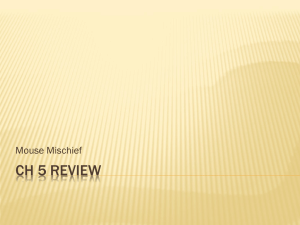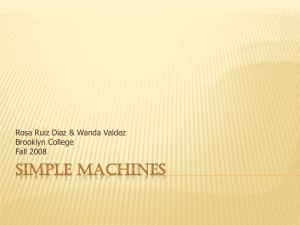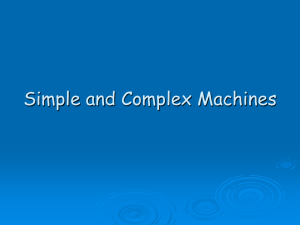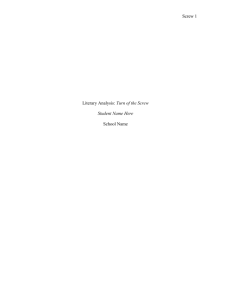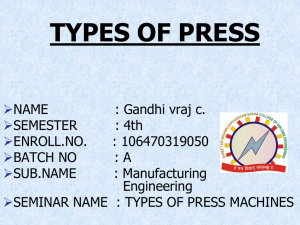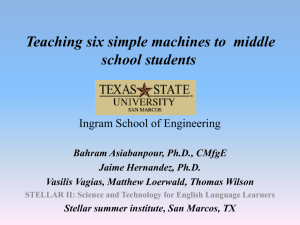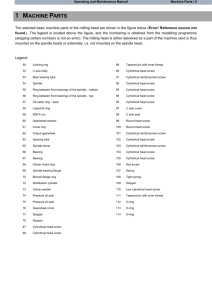Lesson 1 - explore . discover
advertisement
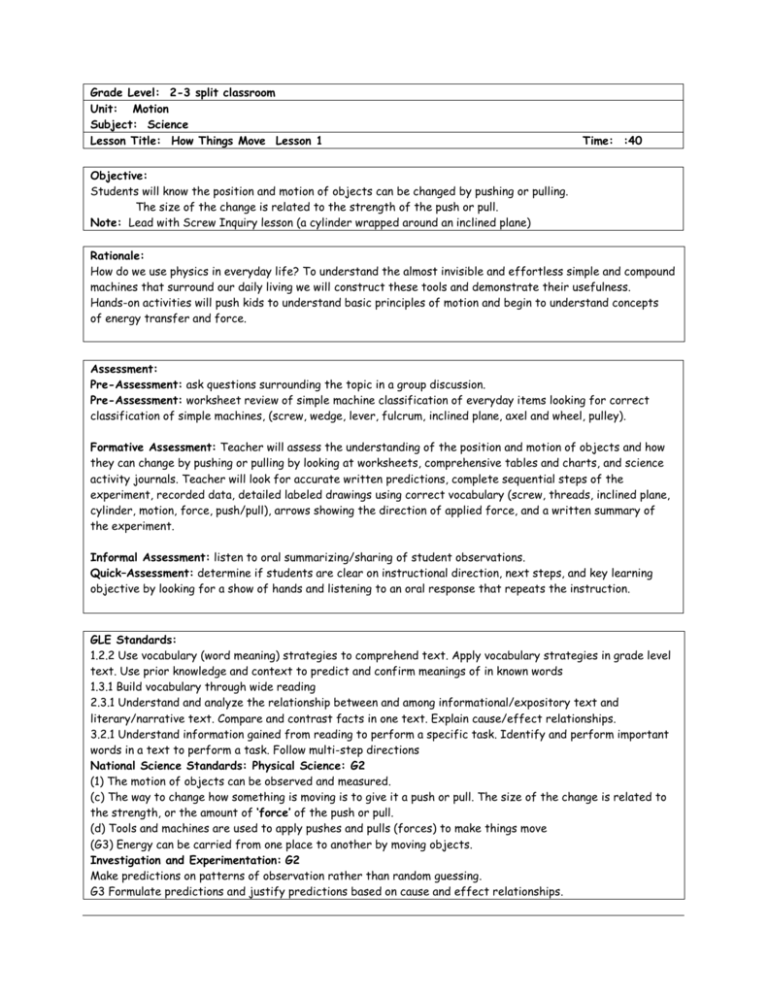
Grade Level: 2-3 split classroom Unit: Motion Subject: Science Lesson Title: How Things Move Lesson 1 Time: :40 Objective: Students will know the position and motion of objects can be changed by pushing or pulling. The size of the change is related to the strength of the push or pull. Note: Lead with Screw Inquiry lesson (a cylinder wrapped around an inclined plane) Rationale: How do we use physics in everyday life? To understand the almost invisible and effortless simple and compound machines that surround our daily living we will construct these tools and demonstrate their usefulness. Hands-on activities will push kids to understand basic principles of motion and begin to understand concepts of energy transfer and force. Assessment: Pre-Assessment: ask questions surrounding the topic in a group discussion. Pre-Assessment: worksheet review of simple machine classification of everyday items looking for correct classification of simple machines, (screw, wedge, lever, fulcrum, inclined plane, axel and wheel, pulley). Formative Assessment: Teacher will assess the understanding of the position and motion of objects and how they can change by pushing or pulling by looking at worksheets, comprehensive tables and charts, and science activity journals. Teacher will look for accurate written predictions, complete sequential steps of the experiment, recorded data, detailed labeled drawings using correct vocabulary (screw, threads, inclined plane, cylinder, motion, force, push/pull), arrows showing the direction of applied force, and a written summary of the experiment. Informal Assessment: listen to oral summarizing/sharing of student observations. Quick–Assessment: determine if students are clear on instructional direction, next steps, and key learning objective by looking for a show of hands and listening to an oral response that repeats the instruction. GLE Standards: 1.2.2 Use vocabulary (word meaning) strategies to comprehend text. Apply vocabulary strategies in grade level text. Use prior knowledge and context to predict and confirm meanings of in known words 1.3.1 Build vocabulary through wide reading 2.3.1 Understand and analyze the relationship between and among informational/expository text and literary/narrative text. Compare and contrast facts in one text. Explain cause/effect relationships. 3.2.1 Understand information gained from reading to perform a specific task. Identify and perform important words in a text to perform a task. Follow multi-step directions National Science Standards: Physical Science: G2 (1) The motion of objects can be observed and measured. (c) The way to change how something is moving is to give it a push or pull. The size of the change is related to the strength, or the amount of ‘force’ of the push or pull. (d) Tools and machines are used to apply pushes and pulls (forces) to make things move (G3) Energy can be carried from one place to another by moving objects. Investigation and Experimentation: G2 Make predictions on patterns of observation rather than random guessing. G3 Formulate predictions and justify predictions based on cause and effect relationships. Teacher PHASE 1: Getting Started (Laying the Groundwork) Engaging the students’ interest in a concept or questions Identifying students’ current conceptions Students Activities What makes everyday objects move? (Force and motion) Are we being invaded by machines ? How many machines do we use on a daily basis that we take for granted? What are they? List them. What is the definition of a screw? (Inclinded plane wrapped around a cylinder.) What are the uses How can we make a screw? Introduce Vocabulary: Screw, Inclined Pane, Wedge, Pulley, Lever, Wheel/Axel. Compound vs. Complex machines Teacher will read read overview, share books for research and answer questions. Teacher will hand out box of everyday items for pre-assess engagement. Teacher Raise questions. Share ideas in group discussion. Pay attention. Participate. Make connections. Predict. Understand lesson goals. Circle time whole group discussion. Write and post stick notes on chart paper. Predictions, questions, brainstorms, make lists. Engage. Students will examine everyday items in a box and fill out worksheet. Box: (spatual, stapler, bolt, jar and lid, several kinds of screws, door stop, chisel, nail, hand shovel, tweezers, bottle opener) PHASE 2: Exploring and Discovering Involving students in hands-on, minds-on exploration of a concept or phenomenon Using students’ questions a starting points for exploration Student Activities Hand out white paper to build a paper screw. Hand out Science Journals. Encourage them to make a chart, record data and write what about what they observe in their activity journal. Describe the experiment in terms of cause/effect relationship. What happened when I held the wrapped paper between my fingers and rotated (the effect)? Why did it do this? What is the difference between a simple and a compound machine? What are the effects of rotational force (your finger) on the screw? How do we use this in everyday life? Observe and assess student work. Students will compare/contrast properties of objects and materials. Student will observe, draw, and record experiment data to analyze and compare in Tables and Graphs in their Science Journal. Students will follow multi-step directions. PHASE 3: Processing for Meaning (Making Connection) Making sense and processing the exploration for meaning Reflecting on the scientific process Teacher Student Activities Give 2 minute warning. Wrap up activity, put away scissors, recycle scraps paper in 15, 14, 13, 12,…3, 2, 1. Gather student’s attention for group discussion. Help students identify and articulate concepts of motion and force, and clarify their thinking. Point to Science notebook and probe for understanding on Stage 2 questions. Organize and evaluate data. Use their newly created model of a paper screw to interpret/synthesize it’s usefulness and to think about the relationship of force and motion. Compare results of each group. One member from each table shares out loud. State hypothesis and describe what happened. Apply understanding, and raise new questions. Talk about what they learned. Compare, question, interpret, analyze, communicate share aloud with group. Use Journal for reference. PHASE 4: Extending Ideas (Branching Out) Exploring other aspects of a concept Extending into other subject areas Teacher Student Activities Direct students to extension questions in scientific journal. Collaborate to assist others (and/or) Pencil, scissors, construction paper Which path is greater? The distance up Answer questions / reflect more deeply Trace, cut fold, tape or glue the pencil or the length of the longest on simple/compound machine chart (for cylinder only) edge of the triangle? What is the definition of a screw? What is the (What it is? How it helps us work? benefit of an inclined plane? Where do Relate new ideas to old ones. we see inclined planes in real-life , How do we use them? Name as many Build a 3-D cylinder to reinforce that a inclined-planes as you can. screw is an inclined plane that wraps (roads that zig-zag, drive way, bath tub, around a cylinder. a boat’s hull, ceiling fan, screw) Hand out paper and template to trace, cut and build a cylinder. Wrap up and mention next lesson. Today explored the function of a screw and in relation to force on motion. Leave them with the question… How does an escalator work? Tomorrow, we’ll experiment inclined planes. I want each of you to think of one machine that uses a screw in everyday life and tell me tomorrow. Modifications: Those who finish early can (1) begin a personal KWL chart to assist with the next lesson and to determine their current understanding of simple machines, (2) complete the Simple/Compound worksheet with greater detail. See “What it is. How it helps us Work” section. Enrichment: I will stretch the learning by offering a choice to those who finish early to assist others in recording their data, to reflect more deeply on their observation and/or to trace a Math net and build a 3-D cylinder. Resources Simple Machines: Guided Interactive animation asks questions about Simple Machines in the House: bedroom, garage, bathroom, and in the kitchen. Follow sequence in whole class discussion. http://www.edheads.org/activities/simple-machines/ The Compound Machine: fulcrum , pulley, and gravity http://www.edheads.org/activities/odd_machine/


